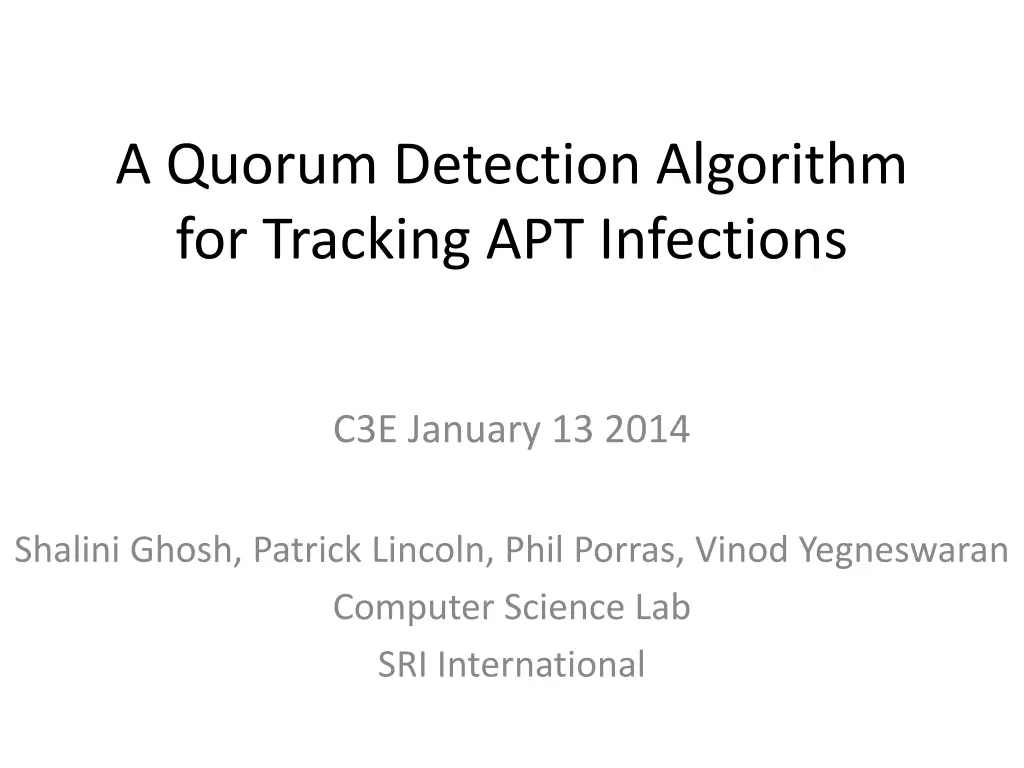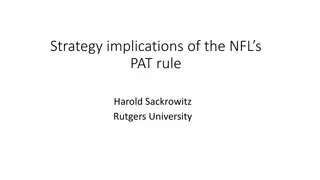
A Quorum Detection Algorithm for APT Infection Tracking
Explore a quorum detection algorithm designed to track APT infections, following a hypothetical APT timeline and focusing on identifying infected internal and external hosts using DNS logs. Dive into a case scenario related to identifying malicious domains used in an attack based on communication with a malicious IP address.
Download Presentation

Please find below an Image/Link to download the presentation.
The content on the website is provided AS IS for your information and personal use only. It may not be sold, licensed, or shared on other websites without obtaining consent from the author. If you encounter any issues during the download, it is possible that the publisher has removed the file from their server.
You are allowed to download the files provided on this website for personal or commercial use, subject to the condition that they are used lawfully. All files are the property of their respective owners.
The content on the website is provided AS IS for your information and personal use only. It may not be sold, licensed, or shared on other websites without obtaining consent from the author.
E N D
Presentation Transcript
A Quorum Detection Algorithm for Tracking APT Infections C3E January 13 2014 Shalini Ghosh, Patrick Lincoln, Phil Porras, Vinod Yegneswaran Computer Science Lab SRI International
Challenge Given DNS logs for a site, identify infected internal and external hosts Hypothetical APT Timeline 1. Phishing email with an enticing link to a malicious site (terrible.au) is sent to staff at some site (lanl). 2. (Minutes to hours later) The recipients see the emails and some click the link. The loaded page detects their browser and OS version, and redirects them to a new host (zaphod.be) with an exploit payload. 3. (Moments later) On some systems the exploit payload is successful. Compromised browser then downloads and executes the second stage. 4. (Twenty minutes later) The second stage begins beaconing home to a third host (gig.bacon.ca). 5. (Several hours later) A malicious actor sends a command to hosts that beacon to establish a control tunnel to the beaconing host over http. Optionally installs backdoors and perniciously persistent presence on compromised machines. 6. (Over the next several hours) The malicious actor gathers documents from that host, and sends them out over https to an external staging area (gord.third.clam). 7. (Over the next few weeks) The malicious actor moves laterally. Infects different hosts in the local network near the newly infected machine, proxying through the initially infected host. Documents gathered are sent to the staging area directly (gord.third.clam). 8. (Indefinitely) Backdoors are established on additional hosts (not all are utilized for document exfiltration and infection spreading).
Our Focus: Case 1 Given: Infected IP, Initial list of malicious DNS, no timeframe Challenge: Derive a criteria to locate other APT- related domains For the first case you will receive a tip concerning a host that has been talking communicating with a malicious IP address and the approximate time the communication started. From this you will need to find the malicious domains used in the attack, only some of which will be connected with the malicious IP given.
Sample Hints in Data 2013-03-04 CASE 1 2013-03-02 As per 2013-03-02, except: host - 74.92.103.13 email received - 2:47 PM Host (74.92.226.44) received a potentially malicious email at 12:30 PM. Timeline: 2:30:20 - User at (74.92.226.44) receives email containing malicious PDF. 2:31:35 - User has opened attachment, which exploits vulnerable adobe acrobat (stage 1) 2:31:36 - Stage 1 contacts malicious domain (zarflugal.noe) over http, and downloads second stage. 2:31:42 - Stage 2 starts periodic http callbacks to second malicious domain (askerpat1sk8nd2.aa9kz- j.ho.ari.do). There are three domains involved: glazes.mrsifor.in (Stage 1 fetch) grandfenagle.in (Stage 2 fetch) shrdhost.mungled.wad (Callback) CASE 1 2013-03-03 As per 2013-03-02, except: CASE 1 host - 74.92.150.57. email received - 11 AM There are three domains involved: telamundo.in (Stage 1 fetch) ethereal.in (Stage 2 fetch) conventional.noe (Callback)
Algorithm: Multi-Host APT Outbreak Detection Filtering: Detect potential APT domains from the massive background domain lookups by benign applications Use overlapping filters Detection: Identify APT beacons using unique behavioral patterns, e.g., Quorum of IP linksets querying the beacon also query a common newbie domain preceding the beacon
Algorithm Schematic Original data Pre-processing : Set of domains that exhibit beacon behavior Filtering: Generates filtered set of beacons via successive filters Detection: Identifies APT beacons using novel algorithm
Before we get into details: Some definitions Newbie: A domain that has not been seen prior to the current (eg. day of) analysis Beacon: A domain that Occurs at least minimum number of times Occurs with long repeat cycle Occurs with limited jitter of repeat cycle Etc.
Algorithm Details Key Steps: Successive, overlapping filtering of beacons Identify linksets (groups of IPs that query a beacon) Identify APT beacons as ones for which a quorum of linkset IPs queried a common preceding newbie domain Results: Can isolate the four multihost APT outbreaks found within the LANL APT dataset on March 5-8
Queries to newbie aejqxgsy.e2 temporally precede queries to beacon provayder.cc Example: Pattern of APT on March 6 also query a newbie domain aejqxgsy.e2 Quorum of 3 IPs 74.92.44.97,74.92.185.4,aejqxgsy.e2,1,0,0,0,252.153.165.50,aejqxgsy.e2,2013-03-06, 13:42:05 74.92.150.220,74.92.185.4,aejqxgsy.e2,1,0,0,0,252.153.165.50,aejqxgsy.e2,2013-03-06, 13:53:02 74.92.227.1,74.92.185.4,aejqxgsy.e2,1,0,0,0,252.153.165.50,aejqxgsy.e2,2013-03-06, 14:04:37 provayder.cc is detected as an APT beacon (verified by hint) 74.92.44.97,74.92.185.4,augerhost.e2,1,0,0,0,252.153.165.75,augerhost.e2,2013-03-06, 13:42:05 74.92.150.220,74.92.185.4,augerhost.e2,1,0,0,0,252.153.165.75,augerhost.e2,2013-03-06, 13:53:02 74.92.227.1,74.92.185.4,augerhost.e2,1,0,0,0,252.153.165.75,augerhost.e2,2013-03-06, 14:04:37 74.92.44.97,74.92.185.4,provayder.cc,20,1137,0,1,55.3.197.114,provayder.cc,2013-03-06, 16:42:08 74.92.150.220,74.92.185.4,provayder.cc,19,1134,0,1,55.3.197.114,provayder.cc,2013-03-06, 16:53:14 74.92.227.1,74.92.185.4,provayder.cc,19,1138,0,1,55.3.197.114,provayder.cc,2013-03-06, 17:04:37 And time interval of repeating > 1000 As it occurs more than 9 times These 3 IPs are part of the linkset for provayder.cc provayder.cc is a beacon
Future Work: Algorithm Extension We are designing an extension of this algorithm that can identify more complex APT patterns Main idea: Relax the beacon filters and do additional post-processing to identifying the APTs present Current Issue: Filter relaxation is leading to data explosion on a single machine, may require a more scalable bigdata analysis framework.
Some Questions Where is the rest of March? We just have up to March 6th Hints for case 2 do not provide rough time frame whereas challenge description indicates you are provided with rough timeframe. Will you provide a timeframe? Hint file 1 is inconsistent. It initially says the infected emails arrives around 12:30, and then in the bullets it says the infected email arrives around around 2:30. There are signficant numbers of cases where either the Query is seen but there is no corresponding Reply or vice versa or my code is buggy. During APT propagation, will the infected host be expected to make DNS queries to find other victim hosts in the network. (Typically, we d expect them to perform direct IP lookups and bypass DNS. Other thoughts?).
Details of Algorithm Extension We make the following modification to the current APT detection code, to get more recall If we see that two or more IPs (instead of >= 3 in the original algorithm) that issue a newbie beacon also issued at least 2 other newbie beacons earlier in the same day, then we mark the IPs as part of a "strong quorum". For each IP of the strong quorum, we list all the newbie beacons issued by them as potential APT domains. This increases the recall of APT domain detection, at the cost of reducing precision.





















